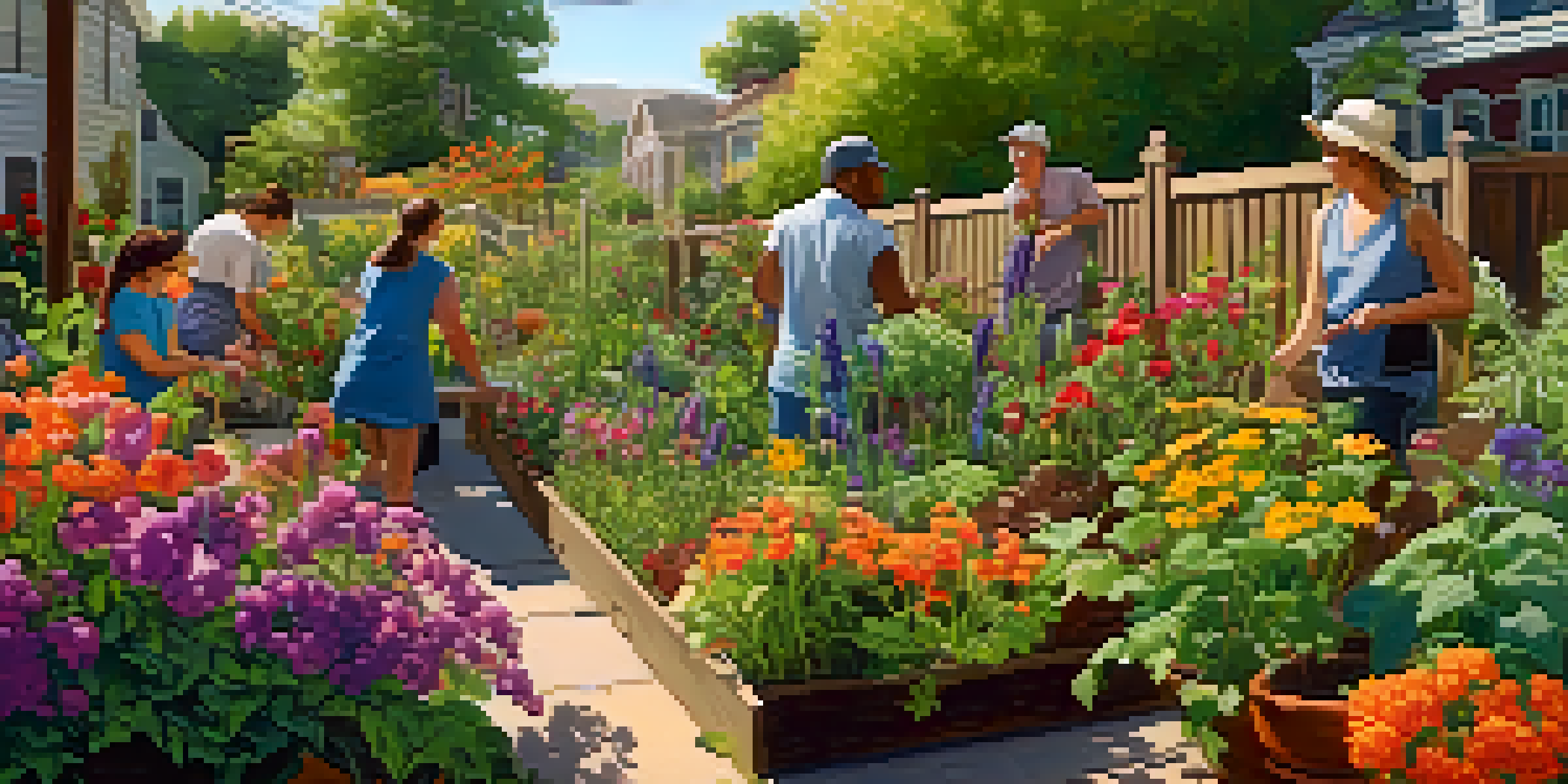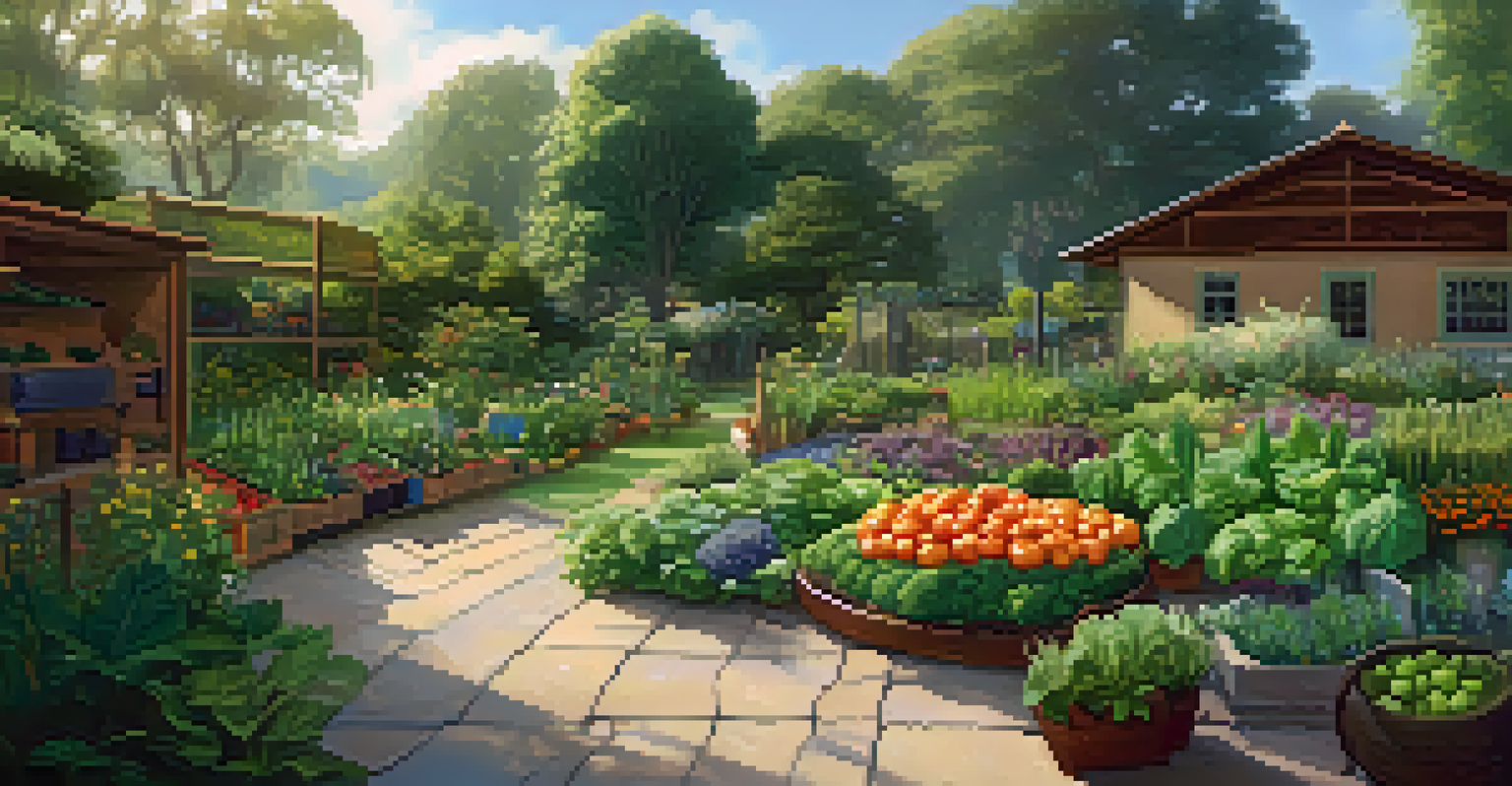Outdoor Sustainable Practices: Trends for Eco-Living

The Rise of Organic Gardening and Its Benefits
Organic gardening has become a popular trend among eco-conscious individuals. It involves growing plants without synthetic fertilizers or pesticides, promoting healthier soil and biodiversity. By choosing organic methods, gardeners contribute to a cleaner environment and often yield tastier produce.
The greatest threat to our planet is the belief that someone else will save it.
Additionally, organic gardening encourages the use of native plants, which are more resilient and require less water. This practice not only supports local ecosystems but also reduces the need for chemical interventions. It's a win-win for both gardeners and nature!
Community gardens are another facet of this trend, bringing people together to share resources and knowledge. These spaces foster connections among neighbors while promoting sustainable practices, making organic gardening accessible to all.
Permaculture: Designing Nature-Inspired Spaces
Permaculture is all about creating sustainable and self-sufficient agricultural ecosystems. It mimics natural ecosystems, allowing for efficient use of space and resources. By designing landscapes that work harmoniously with nature, permaculture minimizes waste and maximizes productivity.

This method encourages diverse planting, which can lead to healthier crops and reduced pest issues. For example, planting certain flowers alongside vegetables can attract beneficial insects that help with pollination and pest control. It's a perfect example of how working with nature yields better results.
Benefits of Organic Gardening
Organic gardening promotes healthier soil, biodiversity, and often yields tastier produce by avoiding synthetic fertilizers and pesticides.
Moreover, permaculture promotes the concept of 'zones,' where gardens are organized based on how often they are used. This thoughtful planning reduces energy expenditure, making gardening a more efficient and eco-friendly endeavor.
Rainwater Harvesting: A Simple Solution for Conservation
Rainwater harvesting is an effective way to conserve water while maintaining a healthy garden. By collecting rainwater from rooftops or other surfaces, homeowners can use this natural resource for irrigation. This practice not only reduces reliance on municipal water but also lowers water bills.
Nature does not hurry, yet everything is accomplished.
Setting up a rain barrel is an easy way to start. These barrels can collect rainwater during storms, providing a sustainable water source for gardens and landscaping. It's a small investment that can make a significant difference in water conservation.
In addition, using rainwater for gardening helps prevent stormwater runoff, which can carry pollutants into local waterways. By capturing this water, gardeners can contribute to a healthier ecosystem while keeping their plants thriving.
Composting: Turning Waste into Valuable Soil
Composting is an essential practice for eco-living, transforming organic waste into nutrient-rich soil. By composting kitchen scraps and yard waste, homeowners can reduce landfill contributions while enriching their gardens. It's an excellent way to practice sustainability in a tangible way.
The process is simple: layer green materials (like vegetable scraps) with brown materials (like dry leaves) to create a balanced compost pile. Over time, microorganisms break down this material, resulting in a rich compost that can be used to enhance soil health.
The Role of Community in Sustainability
Community involvement fosters connections and collective efforts towards sustainable practices, enhancing local ecosystems and economies.
Moreover, composting reduces the need for chemical fertilizers, which can harm the environment. By enriching the soil naturally, gardeners can grow healthier plants and contribute to a more sustainable ecosystem.
Native Plant Landscaping: Supporting Local Biodiversity
Landscaping with native plants is a growing trend that supports local ecosystems. Native plants are adapted to the local climate and soil, making them more resilient and easier to care for. They require less water and maintenance, providing a sustainable option for homeowners.
By choosing native plants, gardeners also support local wildlife, including pollinators like bees and butterflies. These plants provide essential habitat and food sources, helping to maintain biodiversity in the area. It's a small choice that can lead to significant ecological benefits.
Furthermore, native plant landscaping can enhance the aesthetic appeal of any property. With a variety of colors and textures, these landscapes can be both beautiful and beneficial, proving that eco-friendly choices can also be visually striking.
Solar Energy: Powering the Outdoors Sustainably
Harnessing solar energy is an innovative way to promote sustainable outdoor living. Solar panels can power outdoor lights, fountains, and even garden tools, reducing reliance on traditional energy sources. This not only lowers energy costs but also decreases carbon footprints.
Incorporating solar energy into outdoor spaces is more accessible than ever. With advancements in technology, homeowners can find solar solutions that fit their budgets and energy needs. For example, solar-powered garden lights are an easy way to illuminate pathways without increasing electricity bills.
Sustainable Practices for Gardens
Techniques like rainwater harvesting, composting, and using native plants not only conserve resources but also support local biodiversity.
Moreover, using solar energy aligns perfectly with the eco-living philosophy. It's a renewable resource that contributes to a cleaner environment, making it a popular choice for those looking to enhance their outdoor spaces sustainably.
Eco-Friendly Outdoor Furniture: Sustainable Choices Matter
The trend of eco-friendly outdoor furniture is on the rise, as consumers become more aware of their environmental impact. Many brands now offer furniture made from sustainable materials like reclaimed wood, recycled plastics, or bamboo. These materials not only reduce waste but also add unique character to outdoor spaces.
Choosing eco-friendly furniture means investing in quality pieces that are built to last. Unlike conventional furniture that may require replacement after a few years, sustainable options often come with a longer lifespan, making them a smarter investment in the long run.

Additionally, many eco-friendly furniture brands prioritize ethical manufacturing processes. This means that not only are the materials sustainable, but the production methods also consider the welfare of workers and the environment, aligning perfectly with eco-living values.
The Importance of Community Involvement in Eco-Living
Community involvement plays a vital role in promoting sustainable outdoor practices. By working together, neighborhoods can create shared gardens, organize clean-up events, and support local sustainability initiatives. This collective effort enhances community bonds and fosters a culture of environmental stewardship.
Participating in local environmental groups or attending workshops can help individuals learn more about sustainable practices. Knowledge-sharing is essential for spreading awareness and encouraging more people to adopt eco-friendly habits in their daily lives.
Moreover, supporting local farmers and businesses strengthens the community's economy while promoting sustainable practices. By prioritizing local over global, residents can reduce their carbon footprint and contribute to a healthier planet, proving that small actions can lead to significant change.